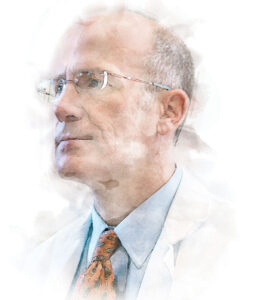

Director of the Cardiovascular Genetics Program and Fellowship Director for Cardiovascular Disease
The Medical University of South Carolina (MUSC)
When Daniel Judge, MD, director of the Cardiovascular Genetics program and fellowship director for cardiovascular disease at The Medical University of South Carolina (MUSC), moved over from John Hopkins a bit over five years ago, the use of genetics in clinical practice was absent in South Carolina.
“When you ask a clinician what genetics means, it’s often infants with phenylketonuria (PKU) or inherited disorders of metabolism,” Judge told Inside Precision Medicine. “But for adults with cardiovascular, pulmonary, or renal disease, not everyone uses genetics routinely in practice.”
So when the opportunity arose to work with population genomics company Helix on a large genomic screening program, Judge was incredibly enthusiastic.
“Here’s an opportunity for us and MUSC to stand apart from the large for-profit hospital centers that operate around the state, and for us to provide an academic and improved healthcare approach to things,” said Judge. “This was the opportunity for clinicians who have been doing good clinical work to bring genetics into their practice.”
In 2021, MUSC launched “In Our DNA, SC,” a first-of-its-kind genomics program to drive preventive, precision health care for South Carolinians. The statewide initiative has set out to enroll 100,000 patients in genetic testing over the next four years at no cost to the patients.
Walking the walk
Excluding COVID-19, the top cause of death in South Carolina is heart disease, followed by cancer. In the time that In Our DNA SC has been up and running, the cancer and heart disease rates haven’t yet begun to go down, but that’s the goal. Judge estimates that the program has detected about 175 positive results, which are split across breast cancer, colon cancer, and hyperlipidemia.
“Many of those patients with those results were quite surprised because they don’t have a family history of cancer or heart disease,” said Judge. “It’s nice to diagnose it because we’re seeing the ability to prescribe medications on the clinical side that are available more readily for people with familial hyperlipidemia or hypercholesterolemia.”
Judge is excited about the opportunity to provide an academic and improved healthcare approach. “It’s an opportunity for clinicians who have been doing great clinical work but haven’t integrated genetics into their primary care, or whatever that practice might be,” he said. “I think the use of genetics in clinical practice…is entering that mainstream. The patient benefits, and the family benefits.”
Judge’s experience in clinical genetics started about twenty years ago, and “I’ve always seen this pattern: once people see a successful use of something like this, they want to do more of it,” he said. “I think our clinicians will witness success with their patients and will want to see more.”
Making genomics part of real-time care

Founder, Helix
Behind the scenes of the In Our DNA SC initiative is a population genomics company called Helix that strives to accelerate the integration of genomic data into patient care and public health decision-making. Founder James Lu, MD, PhD, has dreamt of a world where genetic testing will provide a real-time response versus one that takes weeks. He set his sights on offering top-tier provider and patient experiences by making genomics a part of the healthcare fabric.
Lu thinks the best way to deliver genomics as a data stream or operating system within healthcare is to work with health systems. “Most of our partnerships are with large-scale health systems and are focused on large-scale, population-level programs,” said Lu. “Typically, a hundred thousand people plus, where they inevitably believe that this is going to become the standard of care over time.”
Lu believes that health systems will want to do this because it allows them to identify patients who are clearly at risk and are hiding in plain sight, such as carriers of well-established deleterious DNA variants. Helix went the route of whole exome sequencing (WES) rather than looking at an entire genome, as Lu believes that the coding regions contain almost all the relevant genomic data for clinical decision-making.
With its genomics data, Helix is currently narrowly focused on the diseases that are part of the CDC Tier 1 genomic application toolkit. This set addresses the nearly two million people in the United States who are at increased risk for adverse health outcomes because they have genetic mutations that predispose them to one of three conditions: hereditary breast and ovarian cancer syndrome (HBOC), Lynch syndrome (LS), or familial hypercholesterolemia (FH). The healthcare system currently has a poor understanding of these conditions, and many affected people and their families are unaware that they are at risk; however, early detection and intervention could significantly lower morbidity and mortality.
The type of work that Helix is doing enables health systems to create fresh population health and value-based care algorithms to manage the health of larger populations. Over time, health systems want to drive the cost of care down while improving the quality of patient experiences.
From sea to shining sea
In addition to In Our DNA, SC, Helix currently has five other major programs running across the country that represent over 100,000 people in total, representing potentially one of the largest-scale programs across America’s health systems.

VP of primary care, clinic operations, and laboratories HealthPartners
In addition to South Carolina, Helix is located in Minnesota, where it is working with HealthPartners on a program called “myGenetics.” This large-scale community health research program, which launched in May 2022, is a first of its kind in Minnesota. Implementing this requires knowing what information to analyze, interpret, and communicate to patients, which Leslie Dockan, VP of primary care, clinic operations, and laboratories at HealthPartners, said aligns nicely with its and Helix’s core principle of providing clinicians with clear decision support.
The myGenetics program is free to the patient, given that it is a research project and the goal is to further biomedical understanding. “We wanted to create workflows that were easy for patients and weren’t disruptive to patient visits in the clinic, because our primary care clinicians have so many responsibilities and so many things that are happening,” said Dockan. This required HealthPartners to work closely with its electronic medical group and Helix to create a seamless workflow.

A day in the myGenetics life
After signing up and consenting electronically, the patient gets an automatic email to schedule their lab appointment at a pace that suits them. “They can take their time, ask questions, and review the information at a time when they’re comfortable, not feeling pressured to move into this,” said Dockan.
Once the appointment is scheduled, the patient gives a blood sample and receives clear information on what to expect, including how long sample processing takes and the information researchers will be looking for. From the results, HealthPartners shares information with the patient about the genes that it has screened for and what the results mean, in addition to facts about the patient’s ancestry and other genetic insights.
While this is happening, the clinical results for the CDC Tier 1 Genomic Applications Toolkit gets fed into the patient’s clinical record for any positive results. In the case of such a result, a nurse calls the patient and notifies them of the result, and offers a no obligation appointment with a genetic counselor to talk about their risk, what their results mean, and any additional testing that might be needed. Direct referrals get set up with a specialist. “If you need an oncology, cardiac, or a gastroenterology referral, we do that work for them, put the referral in, order any follow-up labs that may be needed, and set them on a clear clinical pathway,” said Dockan.
This information also goes to the primary care physician as part of the patient’s medical record, which impacts their future health maintenance, namely, how often screening occurs. “If they have a genetic variant, it doesn’t necessarily mean that they have the disease or will get the disease,” said Dockan. “So, we follow them closely and then have that as a part of their ongoing health maintenance and preventative care.”
Dockan said that genomics will be brought into everyday care, such as with pharmacogenomics. “Physicians will be able to see that there are drug-gene interactions,” said Dockan. “If your physician starts to order a drug that’s not going to be compatible with your genetic makeup and how you metabolize drugs, then we want to be able to alert your clinician at the time of order and have them be able to give you an alternative. Today, we have many people on drugs that just don’t work for them, and no one knows why.”
Outreach in every corner
As of June 2023, myGenetics has had 25,000 people consent, which is about the annual number its organizers are shooting for. “We’re starting to see positive results and have more people who are benefiting from this work in a positive way and learning things about themselves,” said Dockan. “We just identified our first early cancer—someone who was underage and not yet even at screening age came back positive for BRCA2. We ended up doing follow-up screening and an MRI, and we found cancer. She’s crediting the program with potentially saving her life.”

Dockan would like to see the next step of the program’s outreach be to everyone who’s due for their annual physical or a preventative exam. “We want to offer it with all of our mammography screenings,” said Dockan. “We have amazing screening rates for mammography, and this is just another layer that takes it even further.”
Dockan also wants to make sure that myGenetics is reaching underserved communities. She tells a story about a black woman in her fifties who has a long history of breast cancer in her family and found out that she was positive for one of the gene variants that put her at higher risk. Dockan thinks that this story can have a major influence on the communities of black women in Minnesota. Not only is there a benefit in getting the word out so that people get better immediate treatment, but the myGenetics team knows that patients of color are underrepresented in a lot of research databases and wants to help fuel new therapies and other ways of fighting disease in local underserved populations.
Judge laments that the program wasn’t in place several years earlier so that it could have worked in time for a famous South Carolina resident, Chadwick Bozeman. The actor developed metastatic colon cancer in his late thirties, well before colon cancer screening was done. Part of the plan for In Our DNA SC is to become one of the top-enrolled genomic screening programs for non-white participants. “We are in the southeast U.S., and while we are in the 15–16% range, we want to be like 30% of our participants who are non-white, predominantly black, representing our state,” said Judge. “When we look at what our goal is for inclusion in this program, we want the demographics in our publications to look like the state of South Carolina. We’re not there yet.”
Jonathan D. Grinstein’s wonder for the human mind and body led him to an undergraduate education in Neural Science and Philosophy and a doctorate in Biomedical science. He has 10 years of experience in experimental and computational research, during which he was a co-author on research articles in journals such as Nature and Cell. Since then, Jonathan hung up his lab coat and has explored positions in science writing and editing. Jonathan’s science writing work has been featured in Scientific American, Genetic Engineering and Biotechnology News (GEN), and NEO.LIFE.













